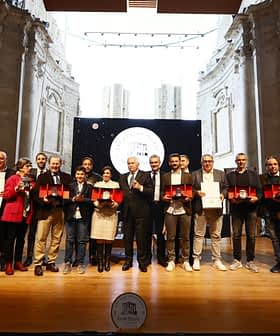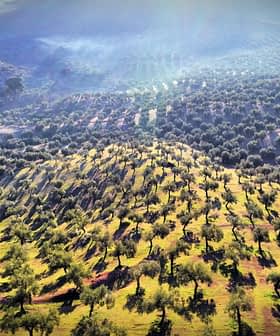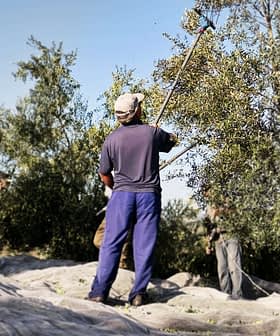Now that the dust has settled on the eleventh edition of the World Olive Oil Competition, it is possible to see some trends through the extensive statistics published by the contest organizers.
See Also:2023 NYIOOC News and FeaturesWhile there are hundreds of data points to analyze, several key themes emerge, pointing to interesting directions in the olive oil world.
Despite poor harvest, a record number of NYIOOC entries and awards
According to preliminary data from the International Olive Council, the 2022/23 crop year was one of the worst in recent memory. Global production reached just 2.73 million tons, the lowest total since 2016/17 and about 17 percent below the five-year average.
Drought and climate extremes across the western Mediterranean basin were widely blamed for the fall in global production.
However, lower yields did not seem to have an impact on quality. The number of entries and awards hit record highs at the 2023 NYIOOC. Overall, producers from 30 countries combined to earn 850 awards from 1,169 entries.
The tally of winning brands far exceeded the previous record set in 2022 of 801, while the number of entries slightly surpassed the 1,156 in 2021. The 73 percent success rate was also the second-highest on record, falling just short of the 74 percent rate reached in 2022.
Digging a bit deeper, participation from Spain did not decline as significantly as its steep fall in production may have suggested.
According to official data, Spain produced 663,000 tons of olive oil in 2022/23, 53 percent below the five-year average. However, the number of entries (135) and awards (106) fell far less dramatically than the average of the previous five competitions, just 9 and 2 percent, respectively.
The situation was similar with producers from Italy, who also suffered a poor harvest not reflected in the number of entries or awards.
At the 2023 NYIOOC, Italian producers earned 174 awards from 224 entries, the second-highest on record after 2021. The haul came after Italy’s worst harvest, in terms of quantity, since 2018/19.
The rise of Southern Hemisphere producers
One of the challenges faced by the NYIOOC organizers has been the difference in harvest times between the northern and southern hemispheres and the objective to analyze samples at their peak of freshness.
The Northern Hemisphere harvest generally runs from September to January, while Southern Hemisphere producers pick and transform their olives from March to July.
This year, NYIOOC organizers split the competition into two segments, judging Northern Hemisphere producers in April and May before evaluating Southern Hemisphere entries in September and October.
While it is hard to define the impact of the change, producers from seven countries across three continents in the Southern Hemisphere combined to earn 101 awards from a record-high 121 entries.
Southern Hemisphere participation was spurred by Brazil producers, who earned a record 48 awards from 53 entries, making the country the seventh-most awarded at the contest. Chile and South Africa also earned a record number of awards.
The rising importance of olive oil quality awards for producers and consumers has seen the number of entries from the Southern Hemisphere steadily increase since 2014. In that time, the number of entries and awards rose by 274 percent and 72 percent, respectively, exceeding the same percent rise in submissions and awards from the Northern Hemisphere.
As a result, Southern Hemisphere producers have seen their success increase relative to the overall growth of the competition. This year, producers from the Southern Hemisphere made up 12 percent of total awards and 10 percent of total entries, a joint record.
Organic olive oil on the rise
Organic extra virgin olive oil is in vogue. Market research indicates that the organic olive oil market was valued at $933 million in 2021 and is projected to rise to $2.2 billion by 2031.
Experts attribute the significant increase in demand for organic olive oil to rising consumer awareness of healthy food and sustainable agriculture.
The growing demand for organic olive oil is reflected in NYIOOC data. At the 2023 World Competition, organic extra virgin olive oil earned a record-high 241 awards from 357 entries. Organic entries enjoyed their second-highest success rate at the competition of 68 percent.
Furthermore, organic extra virgin olive oil entries represented a record-high 31 percent of total entries and 28 percent of total awards. While this latter figure was slightly below last year’s rate of 30 percent and the record-high from 2016 of 31 percent, an upward trend is evident.
The strange story of this year’s blends
Any producer – award-winning or otherwise – will say that creating an extra virgin olive oil blend combines science and art.
Many producers hire specialists to sample each monovarietal to craft a perfectly balanced and harmonious blend.
To the credit of producers and master blenders everywhere, blended and monovarietal extra virgin olive oils have seen similar success in the competition over the years. However, 2023 has proven to be a glaring exception.
This year, blends experienced a 64 percent success rate (352 awards from 546 entries), while monovarietals received an astonishing 80 percent success rate (498 awards from 624 entries).
The 16-point difference between the two is the largest on record. The success rate of blended and monovarietal olive oils often differs by five percentage points or less, which was the case in 2016, 2017, 2018, 2019, 2021 and 2022.
The only other times the discrepancy between monovarietal and blended success rates loomed large were in 2015, when there was a 12-point difference from roughly half as many entries, and in 2020, which had a nine-point difference from a very similar number of entries.
Furthermore, this year’s 64 percent success rate for blended oils was the lowest since 2020, while the 80 percent monovarietal success rate was a record high.
One competition official described the result as “significant, but impossible to explain.”
Perfection from South African producers
Everyone enjoys celebrating perfection. This year, producers from South African producers achieved a 100 percent success rate — 16 awards from 16 entries.
This is an unparalleled feat at the NYIOOC. To put the figure in perspective, countries have only achieved a perfect success rate on 31 of 307 occasions since 2014. However, none did so, with more than seven entries (achieved by Japan in 2021), and 19 of the 31 countries that achieved the feat did so with a single award from a single entry or two awards from two entries.
While this is the least statistically significant data point of the ones listed above, the adversity South African producers overcame to achieve this feat is also worth noting.
The 2023 harvest was marred by an unprecedented year of rolling blackouts, which disrupted irrigation and forced producers to spend more on generators and fuel.
An early start to a cold winter and unusually wet year also hindered the headrest and resulted in lower levels of oil accumulation for some producers.
Still, producers overcame these obstacles to earn a record-high number of accolades.
Congratulations to Albania
One last bonus point from the data analysis: Albania earned its first-ever NYIOOC award in 2023. Producers from the country previously submitted five entries on five different occasions.
Albania’s triumph this year was the second consecutive year a country earned its first-ever recognition from the World Competition. Last year, producers from Montenegro earned three awards from four entries. The only other time a Montenegrin producer submitted an olive oil sample to the competition was in 2014.









